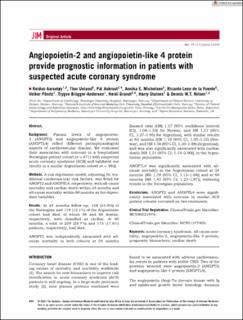| dc.description.abstract | Background
Plasma levels of angiopoietin-2 (ANGPT2) and angiopoietin-like 4 protein (ANGPTL4) reflect different pathophysiological aspects of cardiovascular disease. We evaluated their association with outcome in a hospitalized Norwegian patient cohort (n = 871) with suspected acute coronary syndrome (ACS) and validated our results in a similar Argentinean cohort (n = 982).
Methods
A cox regression model, adjusting for traditional cardiovascular risk factors, was fitted for ANGPT2 and ANGPTL4, respectively, with all-cause mortality and cardiac death within 24 months and all-cause mortality within 60 months as the dependent variables.
Results
At 24 months follow-up, 138 (15.8%) of the Norwegian and 119 (12.1%) of the Argentinian cohort had died, of which 86 and 66 deaths, respectively, were classified as cardiac. At 60 months, a total of 259 (29.7%) and 173 (17.6%) patients, respectively, had died.
ANGPT2 was independently associated with all-cause mortality in both cohorts at 24 months [hazard ratio (HR) 1.27 (95% confidence interval (CI), 1.08–1.50) for Norway, and HR 1.57 (95% CI, 1.27–1.95) for Argentina], with similar results at 60 months [HR 1.19 (95% CI, 1.05–1.35) (Norway), and HR 1.56 (95% CI, 1.30–1.88) (Argentina)], and was also significantly associated with cardiac death [HR 1.51 (95% CI, 1.14–2.00)], in the Argentinean population.
ANGPTL4 was significantly associated with all-cause mortality in the Argentinean cohort at 24 months [HR 1.39 (95% CI, 1.15–1.68)] and at 60 months [HR 1.43 (95% CI, 1.23–1.67)], enforcing trends in the Norwegian population.
Conclusions
ANGPT2 and ANGPTL4 were significantly associated with outcome in similar ACS patient cohorts recruited on two continents. | en_US |

